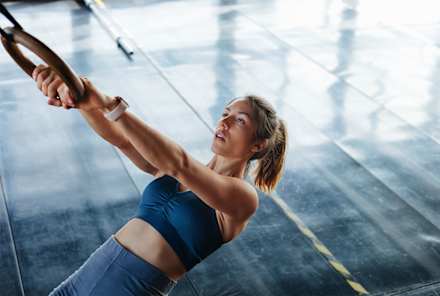Advertisement
How To Safely Practice Yoga Throughout Your Pregnancy



Pregnancy is an exciting (and scary!) time. If it's your first pregnancy, then for the very first time in your life, every decision you make affects not only you but also your precious cargo growing inside. All of a sudden, every morsel that you put into your body has a different meaning, and every move you make has the ability to affect the new life you're growing.
What does this mean for your yoga practice? It depends. If you have a strong, consistent practice, not much has to change, but being pregnant is not the time to "go big" with new yoga poses that your body has never done before. While I always admire the courage of anyone trying to improve their practice, pregnancy is not the time to be introducing new, strenuous movements or routines into your life.
The core truths of yoga are: Listen to your body, stay true to you in every moment, be present, pay attention, be kind to yourself, and take deep breaths. If something doesn't feel right, don't do it!
So with that in mind, here are simple guidelines to keep you and your baby (or babies) safe, happy, and healthy while still practicing yoga during pregnancy.
First Trimester: Avoid overheating and overexercising.
Overheating is common throughout pregnancy, especially in the first trimester. Be sure to have access to a window or fan, and stay hydrated during your practice.
"General guidelines are to keep the heart rate under about 140 beats per minute, and be able to speak while exercising without panting," says Wendie Trubow, M.D., MBA. "You also want to avoid highly heated environments so that the core body temperature stays close to 98.6 degrees Fahrenheit."
It's also a good idea to avoid raising your heart rate too much, and to avoid heating pranayama or retention.
Prenatal yoga poses for first trimester:
In this stage of your pregnancy, most poses are fair fame. But, depending on how many babies you're carrying and how quickly your body changes, you might want to start avoiding deeper forward folds at the end of the first trimester. Instead, try taking a wider stance with your legs to make room for your growing belly.
Second Trimester: No belly poses or extreme backbends.
Generally, in the second trimester, mamas-to-be feel their best. Your belly isn't quite yet in the way, and if you had morning sickness, it most likely has gone away by now. For many, the first-trimester fatigue will have lifted.
Plus, your baby is now much more secure in the place where it will continue growing for the next several months.
Prenatal yoga poses for second trimester:
- Avoid any more poses on your belly, like cobra (bhujangasana), bow pose (shanurasana) or locust (shalabhasana).
- Start modifying any intense abdominal work. For example, bend your knees if you want to do boat pose (navasana), and avoid crow pose (bakasana) and other arm balances.
- Stay away from extreme backbends. Cow pose is a good alternative to upward dog at this point, and your wheel practice will be waiting for you after you are cleared for exercise once the baby has arrived.
- If jumping back and inversions were part of your practice prior to pregnancy, and they feel good, you can begin bringing them back. However, the one inversion that can be difficult is shoulder stand (salamba sarvangasana), as it compresses your lungs. Leave that out if it causes discomfort, as you would with anything else that causes discomfort. A nice alternative to shoulder stand for a pregnant goddess is reclined goddess pose (supta baddha konasana).
- If at any point during your practice you start to feel dizzy, sit down in a kneeling position (vadrasana) with a long, straight spine and take deep breaths.
Third Trimester: Focus on restorative, opening poses.
By now, you are really starting to feel your pregnancy. The fatigue has returned, and your belly is growing more every day. There may be some swelling, there is definitely some heartburn and/or indigestion, you're probably having trouble finding a comfortable position to sleep in, and there are many aches and pains thanks to your ever-changing body.
Your yoga practice now should be entirely about opening, preparing for birth (with lots of hip openers), and nurturing yourself and your growing offspring. If you haven't already, now is definitely the time to get into a prenatal class or find some prenatal yoga routines online.
Prenatal yoga poses for third trimester:
- You need to steer clear of any poses that involve lying on your back. Instead, prop yourself up at an angle with blocks, bolsters, or pillows so that you are not flat on your back. If you are in savasana, you can lie on your left side in a fetal position to encourage better circulation for your baby.
- Do any balancing poses that you wish to do at a wall or with a chair. Your rapidly changing body will knock even the most centered yogi off balance at times.
- Concentrate on restorative moves that create space (like side bends) and make you feel great.
The take-aways.
As you can see, pregnancy doesn't have to completely throw off your yoga routine. With a few mindful adjustments and precautions, you can continue to do yoga without worrying about harming your child or your body. But the bottom line is that, above all, take care of yourself! Only you know what feels right or wrong for you in any given moment. Follow your intuition, and pay careful attention to all of your needs. You will do great, Mama!


















